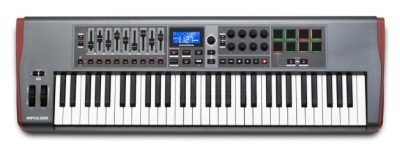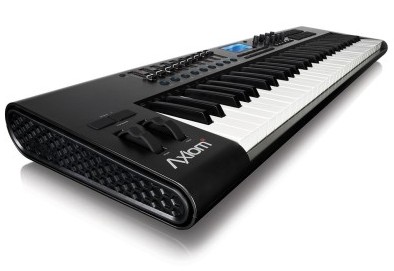In this review of quality and affordable MIDI keyboard controllers, we look at Novation Impulse 61 vs. M-Audio Axiom 61.
Novation Impulse 61
Price: Available on zZounds.com
Keys: 61 Semi-weighted, Lipped Edges
Wheels: Pitch and Modulation
Controls: 9 Faders, 8 Knobs, 8 Drum Pads, Transport Controls, 9 Assignable Buttons
Connections: 1 USB, 1 MIDI In, 1 MIDI Out, Expression and Sustain Inputs
Display: LCD
Power: USB
Accessories: USB Cable, Software/Driver/Manual CD, Installation DVD
Pros: Novation MIDI controllers and keyboards are typically well designed, and the Novation Impulse 61 is no exception. It’s a very ruggedly built device, which makes it very good for live work.
The extra backlighting on various controls is helpful in low-light conditions.
The keyboard has a very solid feel for a semi-weighted keyboard, though the whole unit is a bit light and can move around a fair bit on lightweight stands.
The aftertouch “bounce” is very low on this keyboard. This gives it a much more authentic “piano” feel for the price. I also like the “roll” feature on the drum pads for doing rolls and flams.
I really like the integration capability when working with various DAWs in the studio. I’ve never had the Novation fail to integrate, even with low-end software, as you can always select the “Mackie HUI” mode. The Automap software also emulates “Learn” and “ACT” control programming features that are absent in low-end DAWs, though beginners will still need to learn the MIDI codes for many features.
Cons: Power is supplied through the USB port. If you use other MIDI devices connected to the MIDI ports, you may find this to be a drawback. I’m also not a fan of the low-resolution LCD display.
M-Audio Axiom 61
Price: Available on Amazon
Keys: 61 Semi-weighted, Lipped Edges
Wheels: Pitch and Modulation
Controls: 9 Faders, 8 Knobs, 8 Trigger Pads, Transport Controls, 9 Assignable Buttons
Connections: Power, 1 USB, 1 MIDI In, 1 MIDI Out, Expression and Sustain Inputs
Display: LCD
Power: USB or Power Supply (9VDC)
Accessories: USB Cable, Software/Driver/Manual CD
Pros: The M-Audio Axiom 61 is clearly one of the most popular MIDI keyboard controllers due to its integration with Pro Tools. The LCD can display a great deal of other DAW details, but it really shines in Pro Tools.
All of the controls on the Axiom 61 are re-assignable and feel solid and smooth. You can also re-assign the rotation speed for different functional uses.
The keyboard has a piano-style lipped edge and semi-weighted keys so it feels natural — if a bit “bouncy” — to pianists.
There are two versions of this product. The older version is identifiable by a numerical keypad. Many users miss this feature but find the new version’s layout more usable overall.
Cons: For the cost, Avid might have included the wall-wart power supply. There do seem to be a number of people that have gotten some lemons with the new version due to different factory locations, but most people, including myself, have had no trouble with the M-Audio Axiom 61. Most of the complaints are noisy and/or sticking keys.
Final Tips for Choosing a MIDI Keyboard Controller
Both M-Audio and Novation offer controllers with more options, knobs, buttons, and keys, as do other manufacturers. The keyboard controller you end up going with will depend largely on what style of music you create.
If you’re a trained pianist, you’ll probably want to go with fully weighted keys. If you have experience with organs, you may want to get waterfall edges on the keys for faster slides. If you do a lot of electronica music, you might want more trigger pads for controlling sound effects and loops.
In almost all modern controllers, you can assign any controller to any process within your DAW, so it’s always nice to have more knobs and faders. There are even controllers available that include built-in DAWs and sound cards for using them in standalone modes.
There have been a lot of changes in MIDI keyboard controllers in recent years, and not all of them have been for the better. For instance, a lot of cheaper controllers use a diving board edge on the keys. This makes doing glissandi more difficult, and the keys can be easily broken if you are an aggressive player.
Additionally, many companies have been sold and now use cheaper manufacturing processes that can make the controls sticky and/or noisy.
A great option for film composers can be to visit pawn shops and used music stores to find the “tried-and-true” MIDI devices. The MIDI standard has been around since 1983, and there have been some great keyboard controllers over the years. You might have to play around with a few different models to find out what works best for you.
If you’re buying your first MIDI keyboard controller, be sure to check out our MIDI keyboard buying guide.


Great review. I think it’s time for me to upgrade. I’m noticing I’m making tons of more music and really want to start using trigger pads and stuff. I have an Alesis Q49.
Glad you liked it Josue! More bells and whistles are never a bad thing as long as you’re getting good use out of them 🙂